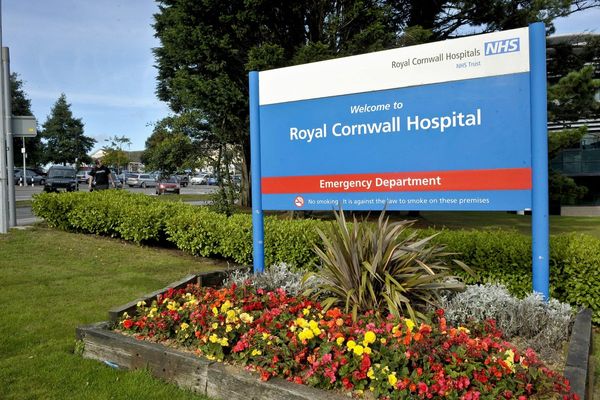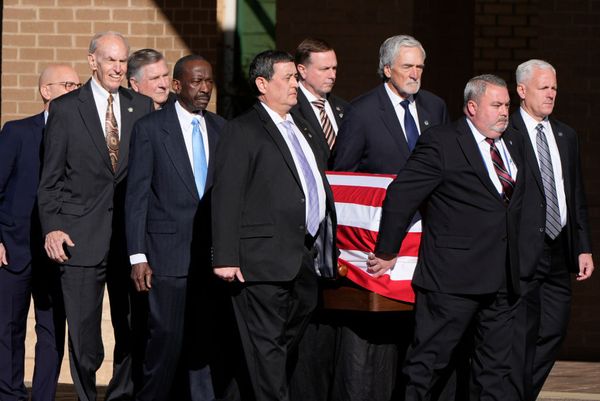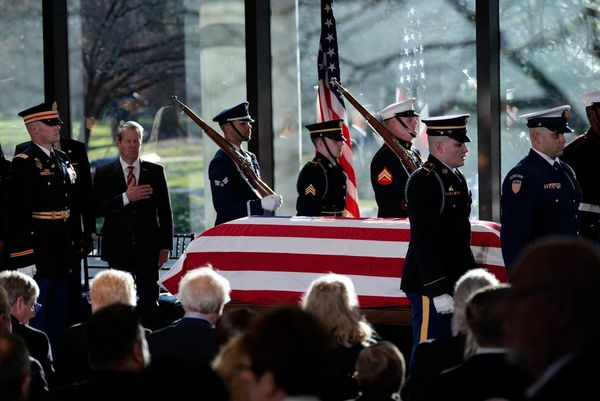
As a golden age cinema countdown on the stage-side screens gave way to a worshipful close-up of a union jack guitar, a roar on a scale never heard at a concert on British soil before greeted a row of five figures, arms around shoulders, owning the biggest stage of their lives. One raised the dregs of his pre-gig drink over his head in a screaming hawk pose, while his brother took to a microphone.
“This is history,” beamed Noel Gallagher, gazing out across a vast horizon of faces. “Right here, right now, this is history.”
And so it remains. By the time Oasis took the stage for the second of two shows at Knebworth Park in August 1996 – dubbed by Liam Gallagher himself as “the Woodstock of the Nineties” – they had played to a combined audience of more than 250,000 people; according to official figures, still the biggest UK live shows in the history of rock. It was also where Oasis planted their flag at the pinnacle of the Britpop era – just three years since being signed they’d become all-conquering rock’n’roll heroes, towering over their peers at an event so definitive of the Nineties guitar explosion that it would prove impossible to follow. Knebworth, the last great blow-out of its era, was where Britpop hit critical mass.
“It felt that everything was leading up to something that was gonna define not only the size of the band, but what British pop music was about at that time,” Noel said in its aftermath. “It all felt like it was leading to Knebworth.”
At considerable velocity too. “There was a new optimism,” says Jake Scott, director of the forthcoming documentary and concert film Oasis Knebworth 1996, released next month. “It seemed like something new was happening with everything, art and fashion as well. The arts in general were bursting.” Most notably in music, where the race for No 1 between Blur’s “Country House” and Oasis’s “Roll with It” in August 1995 – the so-called Battle of Britpop – had captured the general public’s imagination like nothing since The Beatles vs The Stones, lifting the thriving underground Brit-rock scene – boasting such wonders as Pulp, Supergrass, Manic Street Preachers, Elastica, Ash and Suede – into the heart of the mainstream.
Legendarily, Blur won the singles battle but Oasis – cast by the press as rock’n’roll’s latest wildmen thanks to the Gallaghers’ constant rows, drug-taking and searing self-confidence – won the album war. Their 1995 second album (What’s the Story) Morning Glory? was the indie rock phenomenon of the decade, eventually shifting 22 million units worldwide and it’s the UK’s fifth best-selling album of all time. The clamour for tickets for the subsequent tour was no less ardent.
“When they started playing big shows like Sheffield Arena they probably thought ‘this is the level it’s going to go to’ and the level just kept on going up,” recalls Alan McGee, head of the band’s label Creation Records. “We put Maine Road [a stadium show at the home ground of Oasis’s beloved Manchester City in April 1996] on sale, it sold out in about two minutes – back in the day that was some going because the internet didn’t exist at that point. That would’ve just been phone lines. The next one went on sale the next day or whatever it was, sold out, and then you thought ‘well, this is probably it, Manchester, their home ground’ we probably thought that was as big as it was gonna get.”
“They’d obviously got such a head of momentum by April,” says Chris York, one of Knebworth’s two co-promoters. “When we did the two shows at Maine Road, it was clear they had another phase of this 1996 live thing to do.” A charabanc of band, management, agents and promoters was arranged, touring the south of England looking at suitable fields for a festival-sized event. “The capacity was one of the driving factors,” says York. “They wanted to make a statement. We all got to Knebworth, which was the last one we were seeing, we walked in and it just felt like the right setting. From the moment we got there it clearly had a resonance with the band. There was also an element of ‘this is where rock legends play, we are the future rock legends, let’s pick up that baton’.”
Oasis committed to one night at Knebworth with the option of a second; tickets went on sale in May, with fans camping out overnight at venues around the country set up to sell tickets and an army manning the phones. “The time scale, in modern terms, was ridiculously short,” says York. “Three months between putting them on sale and the show date was very ballsy. Bands just don’t sell like that.”
This band did. With 2 million requests for tickets for the show – although York, who was in charge of sales, claims that 10 million calls were logged – the shows sold out in a matter of hours. “Every single ticket that we physically sold on the day was either sold in person or sold to someone hanging on a telephone waiting to get through,” says York. “Because it was such a seismic moment on the timeline of Nineties music, people – even if they were only casual Oasis fans – wanted to be there.”
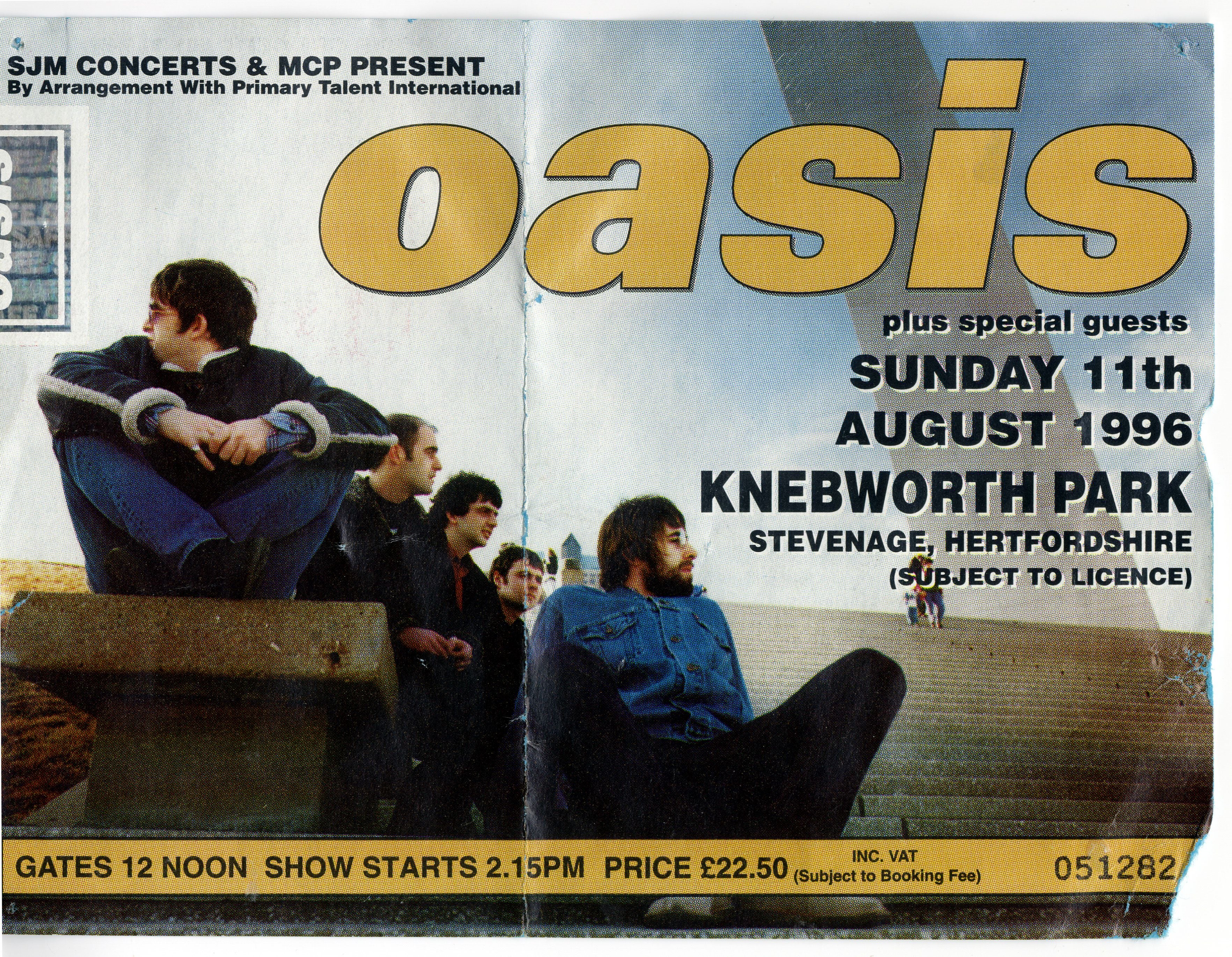
Indeed, had everyone who applied for a ticket received one, Oasis could have sold out Knebworth 20 times over, although that conversation was never held. “They understood the importance of the moment,” York explains. “The beauty of that event was that it was a weekend. If you start adding Mondays and Tuesdays, there’s always gonna be a dip in one of the shows and people talk about the bad night there was and whatever. They just focused on delivering something excellent.”
To which end, a supporting line-up was put together featuring some of the finest acts of the era, among them The Prodigy, Manic Street Preachers, The Charlatans and The Chemical Brothers. “At that moment in 1996, that bill was probably as good as it got,” says McGee. Bottom of the bill, despite boasting arguably the best repertoire of the weekend, The Bootleg Beatles were still soundchecking when the Knebworth gates first opened on Saturday.
“From about four counties away, there was this tidal wave of kids,” says Andre Barreau, their George at the time. “It was like ants. It was unbelievable, fantastic. It was packed, because everybody wanted to get in for the whole event … We had a small orchestra with us so we could do ‘All You Need Is Love’ and ‘Hey Jude’. “Reading Q magazine six months later, one of the guys from The Chemical Brothers said it was a nightmare because they went on and the audience was still singing ‘Na-na-na-na’ from ‘Hey Jude’.”
Backstage, a VIP area for 6,000 guests decked out with pinball machines, a Scalextric set and numerous VVIP free bar tents, was similarly swamped. “When I got there the first thing I saw was Mick Hucknall trying to chat up Martine McCutcheon,” Pulp’s Jarvis Cocker would recall, “that set the standard for the day really.”

“People were blagging to get into whichever free bar tents they could,” remembers York’s co-promoter Conal Dodds. “There were people walking round who had five stickers on. There was a lot of Cool Britannia mob, and lots of footballers and models there.” Dodds recalls offering a woman with small children passes for the fêted Golden Area at the front of the stage for their safety in case of any crushes. “Then some guy said, ‘where did you get those wristbands from?’ and it was [England player] Stuart Pearce. Suddenly there’s a load of footballers and models all trying to get wristbands from me. It was really bizarre to be faced by a sea of faces where you know all of them.”
The most prized pass of the weekend was for the Creation Records VVIP tent, where wine flowed like water. “It cost me personally about a quarter of a million to put that on,” he shudders today. “Now give people a party for quarter of a million or have my quarter of a million, I think I’d rather have my quarter of a million if I was being honest. These are the kind of stupid, f***ed-up things you do when you’re a young man.”
Many an apocryphal A-list legend was born at Knebworth; of Kate Moss helicoptering in a pair of trainers to replace her stilettos so that she could go down the front, and of Liam tearing around backstage on a golf buggy. “I remember standing at the front of the marquee I was working in, and Liam had spotted Ant and Dec,” said caterer Alex Vooght. “He clocked them and drove straight for them in his golf buggy and they had to dive out of the way like cartoon characters.”
“It was at the hedonistic end of the spectrum, Knebworth,” says Dodds. “The whole Britpop/Loaded [magazine] generation was in full effect there. Cocaine was never my thing, never has been, but you’re obviously very aware of it when it’s around you and it was heavily around us. I don’t mean from the band, I mean from virtually everybody that was there. It was a very hedonistic audience.”
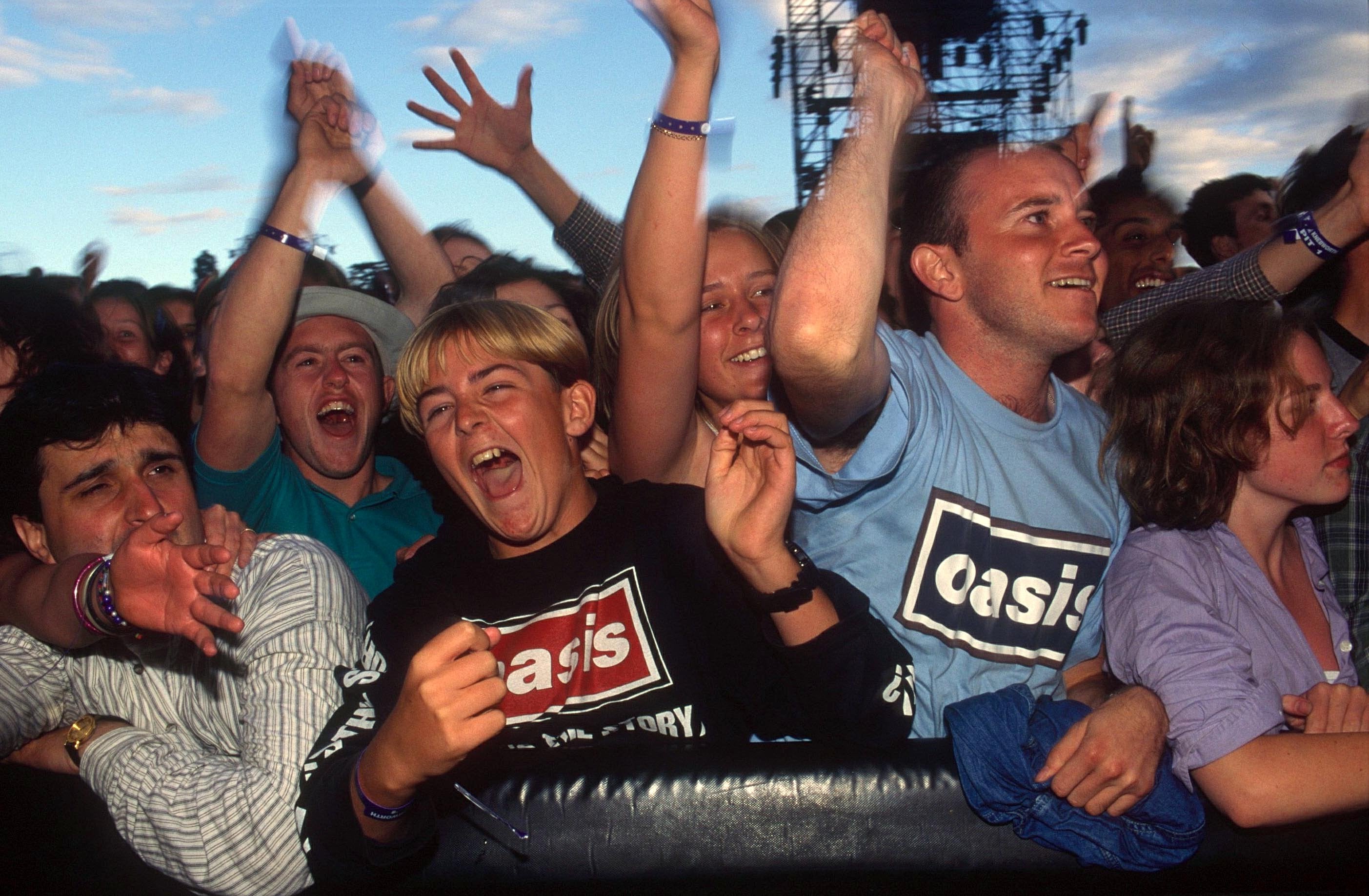
In their behind-stage compound the rest of Oasis, by most accounts, were a bubble of tranquillity amidst the madness – guitarist Paul “Bonehead” Arthurs even complained about the volume of The Prodigy onstage as he was trying to have a pre-gig nap. Having become tabloid fodder thanks to their ballooning notoriety and Liam’s relationship with actor/pop star Patsy Kensit, their reputation was one of cocaine-on-their-cornflakes rock hoggery. But the scale of Knebworth focused them beyond the point of nerves or hedonistic urges.
“I think we were too busy doing it to worry about it,” Noel would say later. “I remember us flying over and just being sort of normal. We were worried about other stuff: ‘Have you got the beers backstage?’, ‘Are they cold?’, ‘And have you got Sky?’, ‘Is it Sky Plus?’ Stuff like that.”
“None of them can remember anything,” says Scott of his interviews with the band for his film. “Some people might assume there was a reason for that but as Noel and Bonehead said, they never went onstage high or drunk, ever. You just didn’t do it because you couldn’t perform at that level and deliver to the fans at that level. They’d stayed up until seven in the morning on the Thursday night because they had some mates come down from Manchester, and you can see that they’re hanging a bit at the soundcheck, looking a little bit worse for wear, but they played brilliantly. And they were fresh as a daisy on the first night… I asked Noel if he was nervous, I asked Bonehead if he was nervous, and they said, ‘I don’t remember being nervous actually’. They were so well rehearsed. Noel said, ‘we rehearsed so much I could do it standing on my fucking head’, and that really comes across.”
“They seemed to take it all in their stride,” says Dodds. “In the snippets of footage that are out there there’s nothing but absolute certainty when that band went on the stage that they totally thought they should be there.”
Oasis took the stage on August 10 kicking huge inflatable footballs into the crowd, Liam greeting the vast crowd by confirming that they were indeed “mad fer it” and crooning a snippet of Blur’s “Parklife” – “all the people, so many people” – as a sly dig at their arch rivals. Then, cranking up a volcanic “Columbia” they launched into what many felt was the greatest show of their lives. “They were brilliant,” says York. “The swagger was there, they wanted to own it. Liam owned it, and that was why Oasis were the band of their generation, because they could go from playing the 100 Club less than two years before to playing a crowd that big, and the attitude hadn’t changed.”
“Noel said it: ‘the band were at their best because Liam was at his best,’” says Scott, whose film hones in on Oasis’s celebratory connection with the audience across the weekend. “There was a wonderfully unifying quality to Knebworth… a magic in the air. One of the accounts was a lad who was there with his mates in the front row. He was saying ‘give us your tambourine!’ and Liam shouts down to him ‘don’t you worry mate, I’ll be down there, I won’t forget you.’ And he didn’t, at the very end, after ‘Champagne Supernova’, he walked down and gave him the tambourine.”
“When John Squire walked on to do ‘Champagne Supernova’ on the Saturday night just as it started raining, I’m sure that’s etched in many a Britpop fan’s mind,” says York. Although, after an exhilarating set featuring such Britpop mainstays as “Cigarettes and Alcohol”, “Supersonic”, “Wonderwall” and “Don’t Look Back in Anger”, their schedule wasn’t etched into the band’s. After closing with their trademark cover of The Beatles’ “I Am the Walrus” they stayed behind the stage to watch the fireworks that were put on specifically to give them time to get offsite before the crowds swamped the exit roads, so were trapped onsite until the hordes had dispersed. Liam took the opportunity to celebrate particularly hard, believing his job for the weekend was over. “I thought we were only doing one night,” he later admitted, “and then we done the second, so I got really drunk after the first night and I can’t remember anything.”
It became both a tired and emotional night for Liam. On a late-night golf buggy tour of the deserted site, he had a rom-com moment with Kensit. “It was 3am, so everyone had gone home and it was completely silent,” she told the Daily Mirror. “Liam turned to me and said, ‘I want you by my side all the time. I don’t want you taking your clothes off in any more s**** movies. I want to take care of you and your son.’ It was actually one of the happiest nights of my life.”
“If we’d have sat down and calculated that we were gonna make history,” Noel said, “I’d have certainly worn a better outfit and I may have gone to bed a little bit earlier, and we may have tried to keep Liam off the sauce.” Rumour has it that Liam was somewhat the worse for wear at the Sunday night performance. “Liam had obviously been having a good day up until the show on the Sunday night,” says Scott of that night’s footage. “You can definitely tell he’s a bit ragged, but in a great way. There’s a lot of swagger to it. Liam’s very lively on the second night, he does a lot of mucking about on stage, he climbs down into the pit and comes back up again and he’s all over the shop. He’s quite delinquent onstage, it’s good fun to watch.”
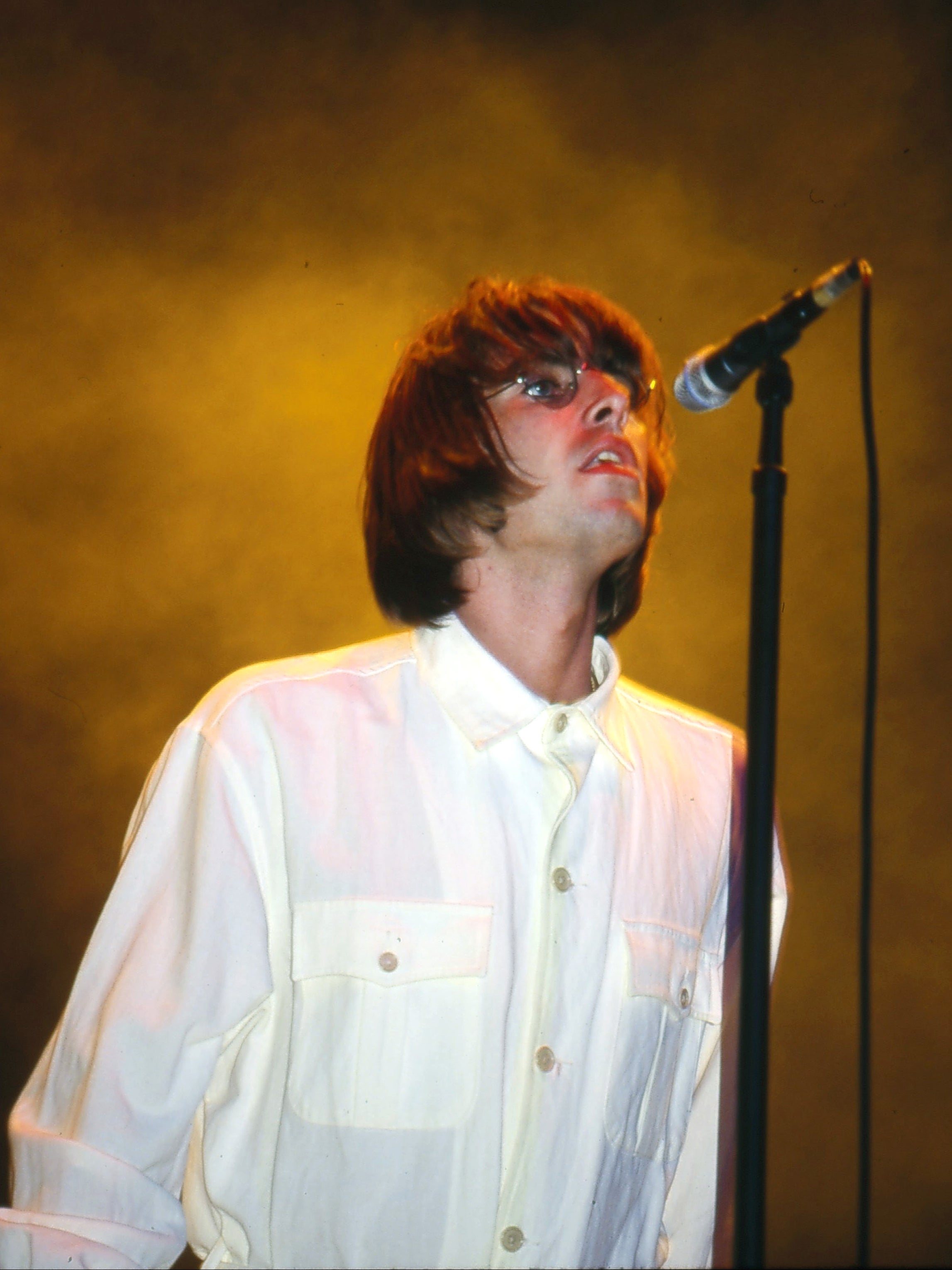
In the aftermath of such a momentous event, however, Noel for one struggled with the view from the very top. “I went back afterwards and Noel was looking a little bit perplexed about where do they take it from there,” McGee remembers. “We had a discussion about it. He couldn’t go any bigger and I was going, ‘let’s do a pay-per-view in Antarctica. We’ll put on a gig, Oasis in Antarctica on a pay-per-view.’ I think he thought I was f***ing mental… I probably thought ‘it’s never going to end’. I probably thought I’d signed The Beatles and they probably thought they were The Beatles. We all probably thought it was gonna go on forever.”
Instead, the band’s very apparent cracks began to widen. Within a month Liam would quit a tour expected to break the band in America at the airport, and in the wake of 1997’s drug-fuelled and indulgent third album Be Here Now the line-up had disintegrated, with Ride’s Andy Bell and Heavy Stereo’s Gem Archer roped in to replace Bonehead and bassist Paul “Guigsy” McGuigan. The band would remain a stadium-level and festival-headlining act until splitting acrimoniously in 2009: the war of words between the Gallagher brothers plays out on Twitter to this day, even as their separate solo careers thrive and reunion hopes fade. But Knebworth would remain their crowning moment, not just – in Barreau’s words – “the zenith of Britpop”, but a breakthrough event for British alternative music that would allow acts such as The Verve, Radiohead, The Prodigy and Coldplay to gain traction worldwide in its wake.
“It took British guitar music out of the doldrums,” York argues. “All of a sudden British bands were on the agenda in the US, success breeds success. They wanted to be the world’s biggest rock’n’roll band and they became the world’s biggest rock’n’roll band and are probably still there or thereabouts if they ever did it again.”
“I’ve got a newspaper where there’s an audience picture on the front page of The Sunday Times,” says Dodds, “and I just remember at the time thinking ‘how many events like this have ever been on the front page of The Sunday Times?’ It felt like Oasis kicked the door in for indie rock’n’roll, that those artists could be the biggest bands in the country, the biggest bands in the world.”
Tickets for ‘Oasis Knebworth 1996’ are on sale now
